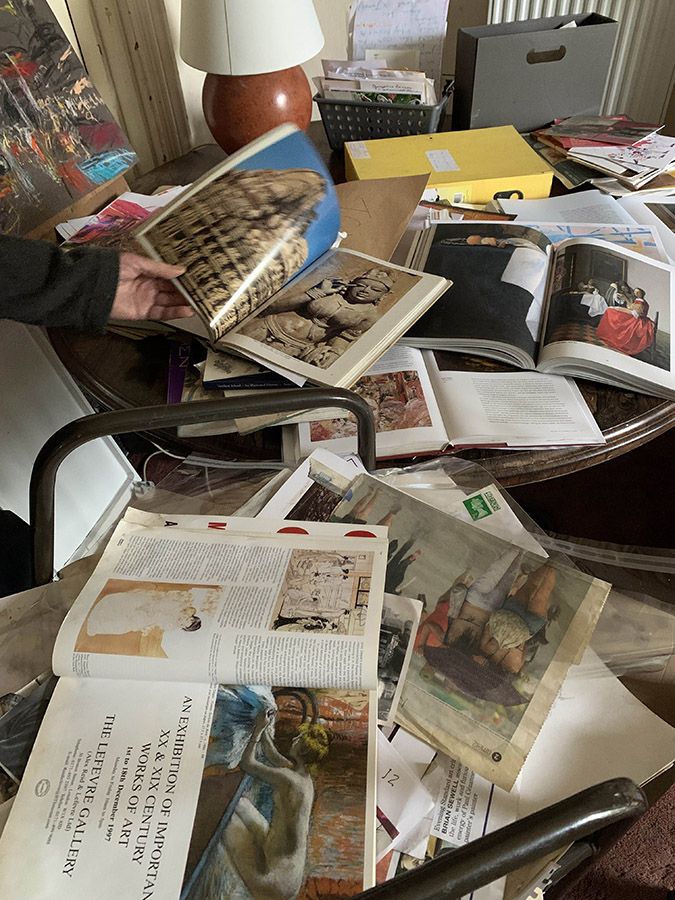In conversation with Anthony Eyton LG
Elected to the London Group in 1961, Anthony Eyton is one of our oldest (100) and longest-serving members. Matthew Kolakowski (Tony’s son-in-law), discusses his historical perspective of The London Group, reflecting on mortality, chaos and positivity.

We meet in Tony’s Brixton house where the ground floor is now his combined studios and living space. His pneumatic bed shares space with his canvases and paints, trays of medications alongside piles of open books and papers. He makes coffee, we get comfortable and talk.
Matthew Kolakowski: Just say what you thought about the London Group show.
Anthony Eyton: I was very impressed indeed. I mean, first of all, the crowd! I was in a wheelchair, and you were taking me around. Yeah. It was very crowded. And I understand it has been crowded all the time.
MK. It was in a good location.
AE. So altogether, I was very impressed with the young non-members’ work.
And very good work. It’s usually on a small scale, but very good. Yeah.
It’s just so happening there in Peckham at this moment.
MK. In the time that you’ve been in the London group, what significant changes have you noted?
AE. That’s very different from the popularity of the London group when I joined. When it was in Suffolk Place, I think, and David Hockney and the young contemporaries had just appeared there. The members were important people like Victor Passmore, and it was the thing to belong to then and was obviously well attended and written about by John Berger and various people. So, it was an important event. With Claud Rogers president, it was a definite alternative to the Royal Academy, which was very much frowned on as being fuddy-duddy. So, it was top dog as you might say in groups. Forget the New English and that kind of thing. Whereas now the New English gets the sales, and perhaps is chocolate boxy a bit. I was astounded by the quality of the input by the members.
MK. This is where the interrogation begins.
So why do you consider yourself an artist with something relevant to contribute to contemporary creative practice?
Tony laughs uproariously
AE. Oh, God. Yeah. I do consider myself a contemporary artist, hopefully, because one is very easily pigeonholed as either a traditional or Euston Road. My feeling is that I can contribute, in that I react to data, visual data, i.e. nature, in a, I think, a potent way, which is not common these days.
MK. What do you mean by potent?
AE. Well, um, I get excited by the visual. By looking out of this window, I get excited very easily. If I’m in a crowd, I get excited. Which I’m saying is not common these days because people are, in a way, blinded to reality almost. And so it’s against the trend and it’s not going to get any mention in any newspaper. Okay? Have I answered that question?
MK. Not really. I mean, do you want me to ask it again?
Why do you consider yourself an artist with something relevant to contribute to contemporary creative practice? It’s me saying, I hear you say, “Why aren’t people paying attention to me? I’ve got something to say.” And I’m saying to you, well, what is it that you’re trying to say that should be listened to?
Long pause
AE. There’s a quotation in the bible about this silent voice. I think it comes in Ezekiel. Where was God? And he wasn’t in the Sunday. He wasn’t in the burning bush. He wasn’t in the drama. He was the still silent voice. Right. That’s what just sort of comes up in my head. But, well, it’s all very magical, really being alive at a 100 and feeling one has got a voice and this sort of following in a way. There’s a certain obstinacy, which says listen to me, because of the fact that I’m alive, and a feeling of something to say. That’s so important enough just to be.

MK. Do you think the fact that you have your 100 years gives you a different perspective?
AE. I had a carer come and he said “You’re 20 years old.” And in a sense, I am 20 years old, because I’m much more alive now to what’s going on in the world. Whereas I was pretty bigoted about 40 years ago. When I was totally kind of Euston Road. I think now I’m much more open to new ideas. I’m seething with ideas, really, which are not necessarily painting out of the window or doing the oak tree at the end of the garden. This is time, to paint people en-masse, Indian pictures, bodies piling up, Listening to marches. I mean It’s slightly more political than I ever would have thought of before…
MK. There’s a definite political strand in your work…
AE. Well I’ve always been interested, I live on Brixton Road and see different sorts of marches going up and down there. But I would now say that I definitely must give it a voice if there’s time.
MK. You did a recent Black Lives Matter painting of the protest?
AE. That’s right. Yes.
MK. And before that, there was Reclaim the Streets.
AE. That was an old one. I was delighted because luckily, my camera worked and I took a shot of them all sitting down.
MK. But were you inspired by the crowd or the political message?
AE. I was impressed that they were peacefully making a protest. You know and they followed it up the next year by smashing things up in the city, but then, they were completely just sitting there. But there was an air of protesting, and it was awfully sort of hunky-dory. Joe (AE’s grandson) was a child, and I remember him being there and that kind of thing. One doesn’t really change, but I’m more consciously young now and open to new ideas.
MK. Right. Okay. I’ve been familiar with your work for the last 20 to 25 years, something like that. Maybe a bit more. What about your Avalanche series?
AE. Oh, yes. Yes. That’s very important.

MK. I thought they were particularly fascinating paintings of this moment in your studio. With a couple of shelves Falling down.
AE. Yes, but that also relates to an avalanche in India where a temple fell into the Ganges. I still have to address that, actually. I’ve got photographs of it happening. It relates to apocalypse and the end of the world and dystopian towers which are going to fall down. In Vauxhall, I have a feeling that in thirty years they won’t be there. I thought of everything falling and crashing around. I did a picture for the Royal Academy. It was of some people milling about in a state of we don’t know what. Ambulances are going about and ruined buildings behind. It showed people in a stressful situation. The avalanche sort of reflected this. Well, it could be the end of the world, faltering at the same time. I contrast that with what I call the eternal verities, which is a still life or something. It would be rock hard like a Velasquez, a Chardin or Giotto. An oak tree. My oak tree symbolizes strength. Something like the big columns you mentioned in Seville cathedral
MK. But at one point, they built the columns too high, and they fell down.
AE. Well, that’s interesting. You see! All this is subject to collapse. If I knew the world was going to end tomorrow, re Martin Luther, I would still plant my apple tree today. It’s a contrast between chaos and stasis, and, as it gets attention – and so nothing’s there. It is there. It’s not there. It’s magic.
MK. So in those avalanche paintings, which were of this event in your studio, which is shelves collapsing and the ensuing chaos, that’s there. You embrace that moment. You saw it as representative of the state of the world or symbolic of the times we live in?
AE. Yes. I think it was a reflection. I think Phyllida Barlow is a great artist. And it’s such that we miss her so much. That work is sort of uncanny and strange, to do with falling down and standing up. Combinations of the two. [Referring to one of the avalanche paintings] It’s that spilt yellow powder on the floor. Said it all, really. It’s spilt, and people wanted to tidy it up. I stopped them. I didn’t want to get rid of the chaos and tidy up.
MK. Because it’s like a frozen moment, isn’t it? And to have it there on your doorstep so to speak, in your studio.
AE. And it’s what’s happening all over the world, really. It’s a strange privilege.
MK. I just want to persist with this kind of chaos of the avalanche. You talk about its relevance to its reflection of, let’s say, the state of the world or a view of how we are at this moment in time. But what about the sense that it’s an event that is related to you personally. It could be said that you precipitated this event by loading up those shelves too much, neglecting them and so that it was an event that was going to happen.
AE. I do believe in making use of, uh, what doesn’t go right.
MK. Okay. What do you mean by that?
AE. Well, it’s related to the honeycomb. Out of the lion came sweetness. Out of the what we call misfortune. Then you ride over it and make something of it rather than be destroyed yourself by the thing. Which you possibly can be. There’s really some good in that.
MK. You’re really quite an optimist, aren’t you?
AE. Quite an optimist. That’s right. And, I mean, sudden death. Oh, God forbid. I don’t know how well I would cope…
(At this moment we both look at each other and burst out laughing at the absurdity of this statement.)
… but, I mean, not my death, just anybody’s death!
MK. Right. I thought you’re referring to your own mortality there.
AE. No. I don’t think so. I’m not realistic enough about that. I’m sort of thinking I might go on quite a long time. Angry. Because I’ve got a lot to do. I do feel some urgency about it. It’s difficult, though, to fit into the agenda of exhibitions and that kind of thing.
MK. But you were talking about making use of misfortune?
AE. Well, if you can go around it or make good out of failure, we’ll say to succeed. I mean, Matisse said that out of obvious failure, he would do the reverse. He said you almost bring it on yourself to have a failure, and then impose your will on it.
MK. So that it’s not only an attitude to life so much as a working method.
AE. [Laughs] I don’t want to bring stuff on. It sounds as if I’m trying to create chaos and then do it. No. I’m just saying if it happens. I think I annoy my daughters a little bit by being cheery about it, oh well, um, too bad. Uh, we’ll get the better of that. Well, I can’t see myself properly as other people.
MK. In the realm of misfortunes in this world and the times of pandemic lockdown, you have been working on a book project with your daughter Sarah.
AE. It’s called Anthony Eyton by Sarah Eyton. It’s excerpts taken from the Lockdown Diaries I made.
MK. It’s a joint project?
AE. Yes, it’s got my reactions to the lockdown and it’s accompanied by very fresh and rather marvellous photographs of my pictures and with me working on them. Her photographs are Velasquez-like. Very good in themselves. A father and daughter can work together and make something out of the not very good. One of these chaotic things we’ve been talking about. Do you see a connection? I mean, to use the positivity coming out of the lockdown. I think it’s illustrating a lot of what we’ve been talking about.
Anthony Eyton LG was in conversation with Matthew Kolakowski PPLG, 2023
Anthony Eyton has been a London Group Member since 1961.
Claude Rogers was the President of The London Group between 1952 – 1965

